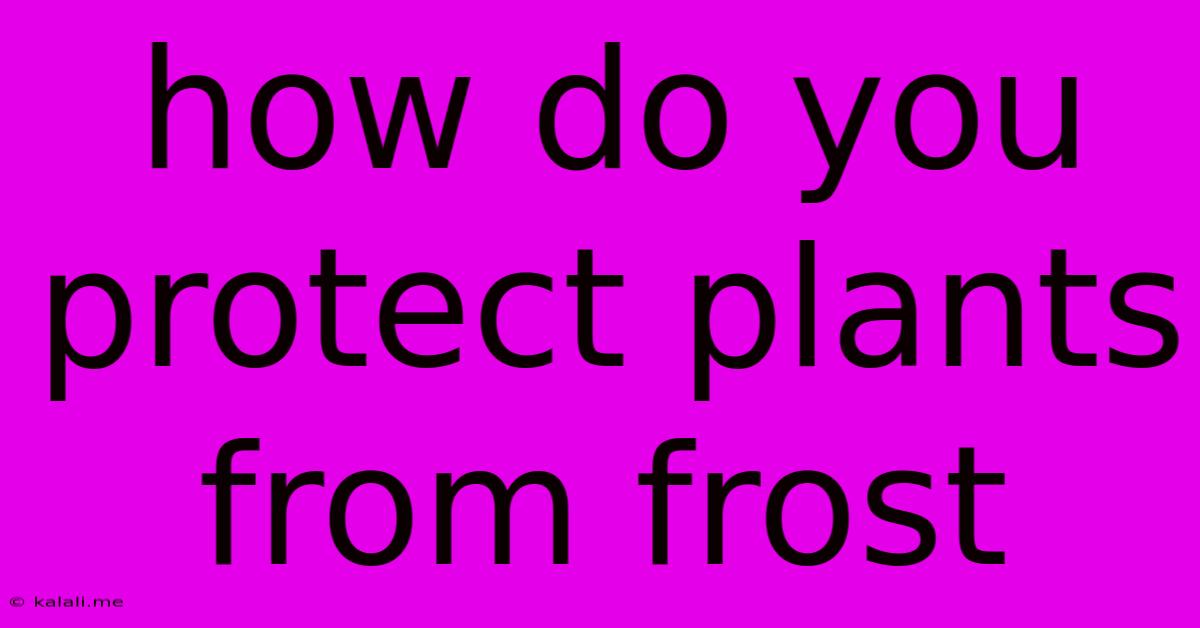How Do You Protect Plants From Frost
Kalali
Jun 08, 2025 · 3 min read

Table of Contents
How to Protect Plants from Frost: A Gardener's Guide to Winterizing
Frost. That dreaded word that sends shivers down the spine of even the most seasoned gardener. A sudden drop in temperature can wreak havoc on your beloved plants, causing irreversible damage and potentially killing them. But fear not! This comprehensive guide will equip you with the knowledge and techniques to effectively protect your plants from frost and ensure their survival through the colder months. This article covers various methods, from simple covers to more involved structural protection, helping you choose the best approach for your specific needs and plant types.
Protecting your plants from frost involves minimizing the impact of freezing temperatures. This means preventing ice crystals from forming within plant cells, which cause irreparable damage. Understanding this process is key to choosing the right protection method.
Understanding Frost Damage
Frost damage occurs when the temperature drops below freezing (0°C or 32°F), causing water within plant cells to freeze and expand. This expansion ruptures cell walls, leading to wilting, discoloration, and ultimately, plant death. Tender plants, seedlings, and newly planted specimens are particularly vulnerable.
Identifying Plants at Risk
Before the first frost hits, assess your garden. Identify which plants are most susceptible to frost damage. These typically include:
- Tender annuals: Many bedding plants and summer flowers are not frost-hardy.
- Young seedlings: Young plants lack the established root systems to withstand cold temperatures.
- Newly planted perennials: Newly planted perennials haven't had time to establish strong root systems.
- Tropical and subtropical plants: Plants from warmer climates are extremely sensitive to frost.
Practical Methods for Frost Protection
Now, let's delve into the practical solutions for safeguarding your plants:
1. Covering Plants: This is perhaps the most common and effective method.
- Floating row covers: Lightweight, breathable fabrics that allow sunlight and air circulation while providing a protective barrier against frost.
- Blankets, sheets, or burlap: These offer excellent insulation, particularly for larger plants or shrubs. Secure them firmly to prevent them from blowing away.
- Plastic sheeting: While effective at trapping heat, ensure adequate ventilation to prevent condensation buildup, which can harm plants.
- Cloches: Bell-shaped covers ideal for protecting individual plants or small groups.
2. Water your plants: Watering plants thoroughly before a frost can help insulate the soil and prevent the ground from freezing too quickly. This added moisture holds more heat than dry soil.
3. Relocating plants: Potted plants can be easily moved to a sheltered location indoors, in a garage, or against a south-facing wall.
4. Mulching: A thick layer of mulch around the base of plants helps insulate the roots and protect them from freezing temperatures. Use organic materials like straw, leaves, or wood chips.
5. Creating microclimates: Strategically planting frost-sensitive plants in sheltered areas, such as near walls or fences, can help create a warmer microclimate.
6. Using Cold Frames or Greenhouses: For more significant protection, consider using a cold frame or greenhouse. These structures provide a controlled environment that helps maintain warmer temperatures.
Choosing the Right Method
The best method depends on several factors, including the severity of the frost, the type of plants, and your available resources. For a light frost, a simple cover might suffice. However, for a severe frost, more substantial protection, such as a cold frame, might be necessary. Always monitor weather forecasts and adjust your protection strategy accordingly.
By following these guidelines and adapting them to your specific situation, you can significantly reduce frost damage and ensure your garden thrives even during the coldest months. Remember that prevention is key, and proactive measures will save you time, effort, and heartache in the long run. Happy gardening!
Latest Posts
Latest Posts
-
How Long Does Feta Cheese Last Once Opened
Jun 08, 2025
-
How Do You Say Royal Person In Japanese
Jun 08, 2025
-
Can You Use Dry Erase Markers On Glass
Jun 08, 2025
-
How To Take A Vacation At A Job
Jun 08, 2025
-
How To Secure A Dishwasher To Granite Countertop
Jun 08, 2025
Related Post
Thank you for visiting our website which covers about How Do You Protect Plants From Frost . We hope the information provided has been useful to you. Feel free to contact us if you have any questions or need further assistance. See you next time and don't miss to bookmark.